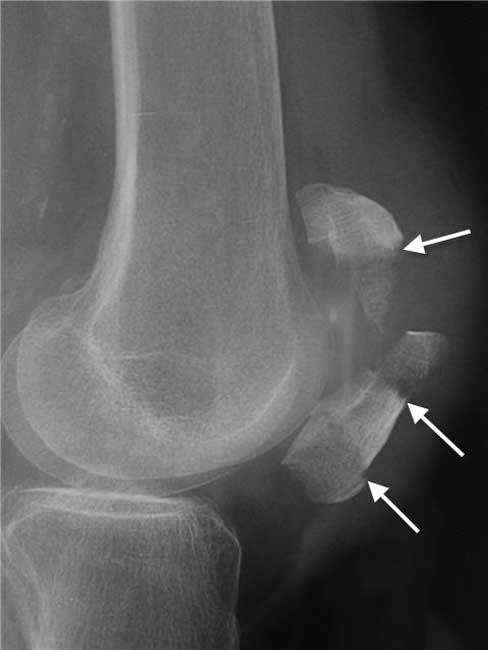Patellar Fracture Treatment in Dallas & Frisco
Stable, Displaced, Comminuted, and Open Patellar Fractures

Dallas & Frisco Patellar Fracture Treatment Specialist
Bone fractures are obviously never fun. They’re extremely painful, and require careful treatment for several weeks, if not months. When a patellar fracture occurs, it’s extremely important to see a doctor as soon as possible. Depending on the severity of the injury, surgery is sometimes necessary. The best way to determine what treatment you need is to visit a Dallas orthopedic specialist.
At SPORT, we handle a wide variety of sports injuries and other conditions. Not only do we offer orthopedic treatments, we also offer Dallas physical therapy. Our team has extensive education and experience, so you can rest assured that you’re in good hands. For more information, or to schedule an appointment with us, please call 469-200-2832. You can also fill out our online intake form.
Anatomy of the Kneecap
The small, round bone at the front of the knee joint is the patella. It sits where the femur and the tibia meet. Its function is to protect the front of the knee, as well as to connect the muscles of the front of the thigh to the tibia.
A smooth material called articular cartilage covers the ends of the femur and the undersides of the patella. As you move your knee, this cartilage allows the bones to glide freely along each other.
What Is a Patellar Fracture?
A patellar fracture is a break of the patella, or kneecap, which is the tiny, round bone at the very front of the knee. Because the patella functions as protection for your knee joint, it is prone to fracture if you fall on it directly or if it collides with the dashboard in a car accident. A patellar fracture is a significant injury that can make walking or straightening your knee difficult, if not impossible.
A cast or splint can be used to treat some minor patellar fractures while the bone heals. The fragments of bone in most patellar fractures, on the other hand, migrate out of position when the injury occurs. Surgery is required to repair and stabilize the patella and allow for the restoration of function in these more severe fractures.

Types of Patellar Fractures
The patella can break in a variety of ways. A fracture might be a simple and clean, two-piece break or a multiple-piece break. A break can happen at the top, middle, or bottom of the bone. Fractures of the kneecap can occur in more than one location. Below, we list the types of patellar fractures you might experience.
Stable Fracture
Nondisplaced fractures are the most common kind. The bone fragments may be in touch with one another or separated by only a millimeter or two. The bones of a stable fracture generally stay in place throughout healing.
Displaced Fracture
The fractured ends of the bone are separated and do not line up correctly in a displaced fracture. It’s also possible that the typically smooth joint surface will be disturbed. This sort of fracture frequently needs surgery to rejoin the fragments of bone.
Comminuted Fracture
The bone shatters into three or more fragments in this sort of fracture. A comminuted fracture can be either stable or unstable, depending on the pattern of the fracture.
Open Fracture
An open fracture occurs when a bone breaks in such a way that bone pieces protrude through the skin or when a wound penetrates the bone. An open fracture is more likely to cause harm to the soft tissues surrounding it, and it may take longer to heal.
This type of patellar fracture is particularly dangerous. Once the bone breaks through the skin’s surface, both the wound itself and the bone are at risk of infection. To lower the chance of infection, seeing a doctor should be your top priority.
What Causes a Patellar Fracture?
Most of the time, patellar fractures result from one of two causes.
- Falling onto the knee directly
- A sharp blow to the knee, such as when the knee hits the dashboard during a vehicle collision
It is also possible to experience an indirect fracture. For example, if the quadriceps muscle contracts suddenly, it can pull apart the patella.
Symptoms of a Patellar Fracture
Pain and swelling in the front of the knee are the most typical signs of a patellar fracture. Other signs and symptoms to look out for include the ones listed below.
- Bruises
- An inability to keep the knee extended in a leg raise
- Inability to straighten the knee
- Inability to walk
How to Diagnose Patellar Fractures
Your doctor will likely begin with a physical examination of the area. Your doctor will check your knee after discussing your symptoms and medical history. Especially if the fracture is displaced, the margins of the fracture may frequently be felt through the skin.
Your doctor will check for hemarthrosis throughout the examination. Blood from the shattered bone ends accumulates inside the joint space in this situation, producing severe swelling. If there is a lot of blood in your knee, your doctor may drain it to help you feel better. In many cases, doctors also order imaging tests.
X-Rays
X-rays are used to see dense things like bone. To check for a fracture and see how the bones are aligned, your doctor will request x-rays from a variety of angles.
It’s possible that a person is born with additional bones in the patella that haven’t fused together. Bipartite patella is a condition that might be misinterpreted for a fracture. X-rays will aid in the diagnosis of bipartite patella. Your doctor may order an x-ray of your second knee as well, because many patients have the problem in both knees.
Treatment for Patellar Fractures
Both surgical and nonsurgical treatments exist for a patellar fracture, depending on the type and severity of the injury.
Nonsurgical Treatment
You may not require surgery if the bone fragments are not out of position (displaced). A cast or splint may be used by your doctor to maintain your knee straight and restrict leg mobility. This will maintain the fractured bone ends in the correct place while they mend.
You may be able to bear weight on your leg while wearing a cast or brace, depending on your exact fracture. Weight bearing is not allowed for 6 to 8 weeks with certain fractures. Your doctor will discuss weight-bearing limitations with you.
Surgical Treatment
If the bone fragments are displaced, knee surgery will almost certainly be required. Patellar fractures that aren’t close together have a hard time healing or don’t heal at all. The thigh muscles that link to the top of the patella are quite powerful, and they can pull the fractured fragments out of position throughout the healing process.
If the skin around your fracture has not broken open, your doctor may advise you to wait until any lacerations heal before undergoing surgery. Open fractures, on the other hand, have a higher risk of infection and must be treated as quickly as possible, generally within hours. The wounds from the injury, as well as the surfaces of the bone, are completely cleaned out after surgery. In most cases, the bone will be treated at the same time as the wound.
Surgical Procedures for a Patellar Fracture
The technique used is frequently determined by the type of fracture you have. Your doctor will go through the process with you before the operation, as well as any potential problems.
Transverse Fracture
Screws, pins, and wires, as well as a figure eight design tension band, are commonly used to hold these two-part fractures in place. The two parts are held together by the figure-of-eight band.
This technique is most effective for repairing fractures in the middle of the patella. Fracture fragments at the kneecap’s ends are too tiny for this treatment. The tension band might over compress breaks that are in many parts.
Another option for treating a transverse fracture is to use tiny screws or small screws and plates to fix the bones together.
Comminuted Fracture
The top or, more often, the bottom of the patella is split into many tiny fragments in certain fractures. When the kneecap is initially pushed apart by the injury and then crushed as the patient falls, this type of fracture develops. Your doctor will remove the bone pieces since they are too tiny to be put back into place. The loose patellar tendon will subsequently be reattached to the remaining patellar bone.
Your doctor may use a mix of wires and screws to repair the kneecap if it is fractured in several parts at its core and the pieces are separated. Small parts of the kneecap that cannot be rebuilt may also be removed, with positive results. In the case of a comminuted fracture, complete removal of the kneecap is a last option.
What Is Recovery Like for a Patellar Fracture?
Recovery includes three major steps: pain management, rehabilitation, and weight bearing.
- Pain management: For a few days to a few weeks, most fractures ache considerably. Many people discover that applying ice to the afflicted limb and using non-prescription pain relievers are all that is required to alleviate discomfort. If your pain is severe, your doctor may recommend taking a prescription-strength drug for a few days, such as an opioid.
- Rehabilitation: Rehabilitation will be critical in bringing you back to your regular activities, whether your treatment is surgical or nonsurgical. Because treating a patellar fracture sometimes necessitates immobilizing your leg in a cast for an extended length of time, your knee may stiffen and your thigh muscles may weaken. During recovery, your doctor or physical therapist in Dallas will give you exercises to help you increase your range of motion, strengthen your leg muscles, and reduce stiffness.
- Weight bearing: When you can start bearing weight on your leg, your doctor will notify you. Initially, weight-bearing exercises are generally confined to lightly touching your toes to the ground. You will eventually be able to put greater weight on your leg as your injury heals and your muscles develop.
Complications of Patellar Fractures
Some individuals with patellar fractures may have long-term problems even after effective treatment.
Posttraumatic Arthritis
A form of arthritis that develops after an accident is known as posttraumatic arthritis. Even if your bones heal correctly, the articular cartilage that covers them might be injured, resulting in discomfort and stiffness. Only a tiny fraction of individuals with patellar fractures develop severe arthritis. Mild to moderate arthritis, also known as chondromalacia patella, is far more prevalent.
Muscle Weakness
After a fracture, some individuals may have persistent quadriceps muscle weakness in the front of the leg. It’s also typical to lose some knee mobility, including straightening and bending. This lack of mobility is typically not debilitating.
Chronic Pain
Patellar fractures are known for causing long-term discomfort at the front of the knee. While the exact origin of this discomfort is unknown, it is most likely linked to posttraumatic arthritis, stiffness, and muscular weakening. Some patients find that wearing a knee brace or support makes them feel more at ease.
Patellar Fracture Treatment in Dallas & Frisco, TX
At SPORT, we offer top-of-the-line treatment options so that our patients can focus on their recovery. If you suffered a patellar fracture, we’re here to help with a treatment plan that involves collaboration between orthopedic specialists and physical therapists in Dallas. For more information or to schedule an appointment, please call our office at 469-200-2832 or fill out our online intake form.


